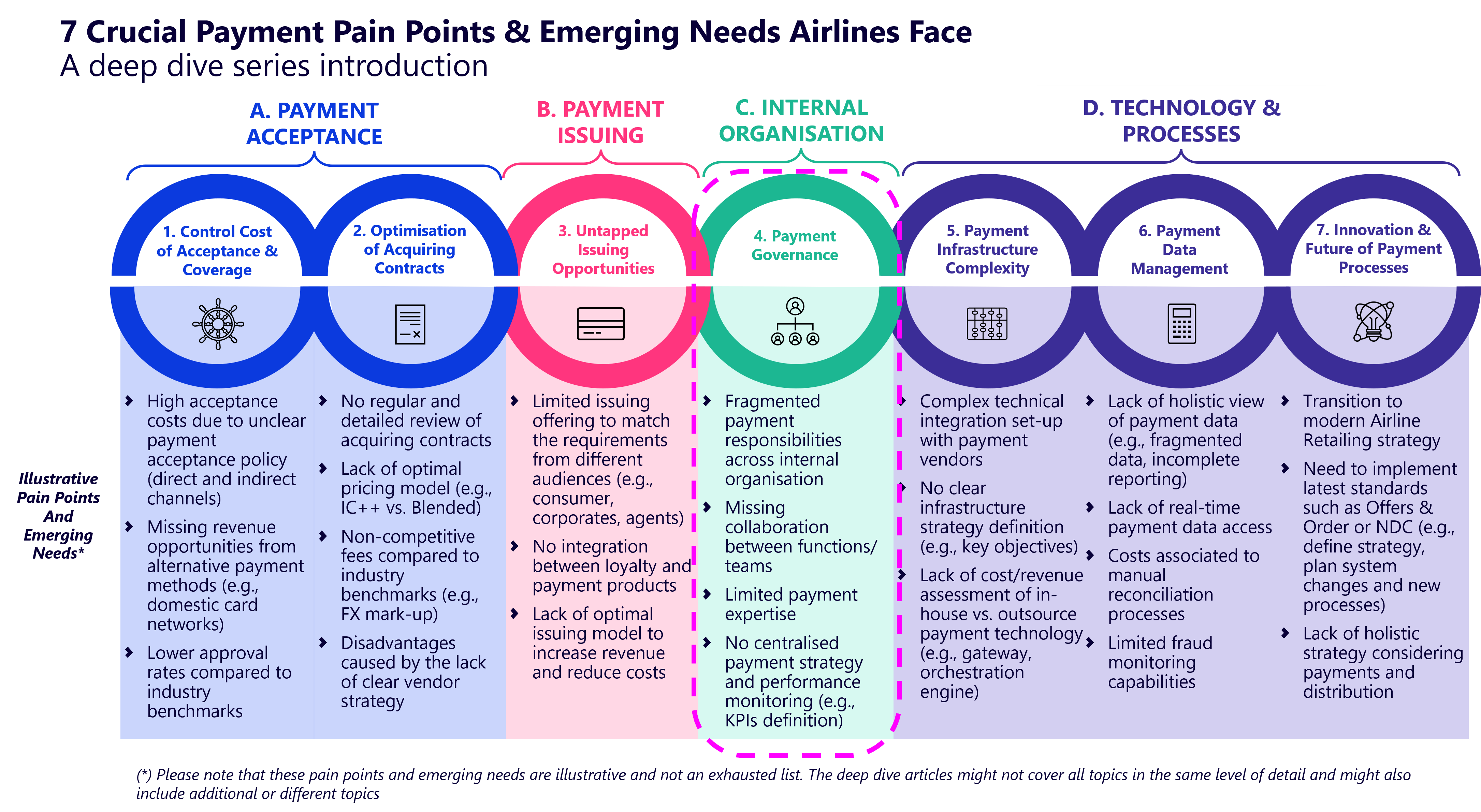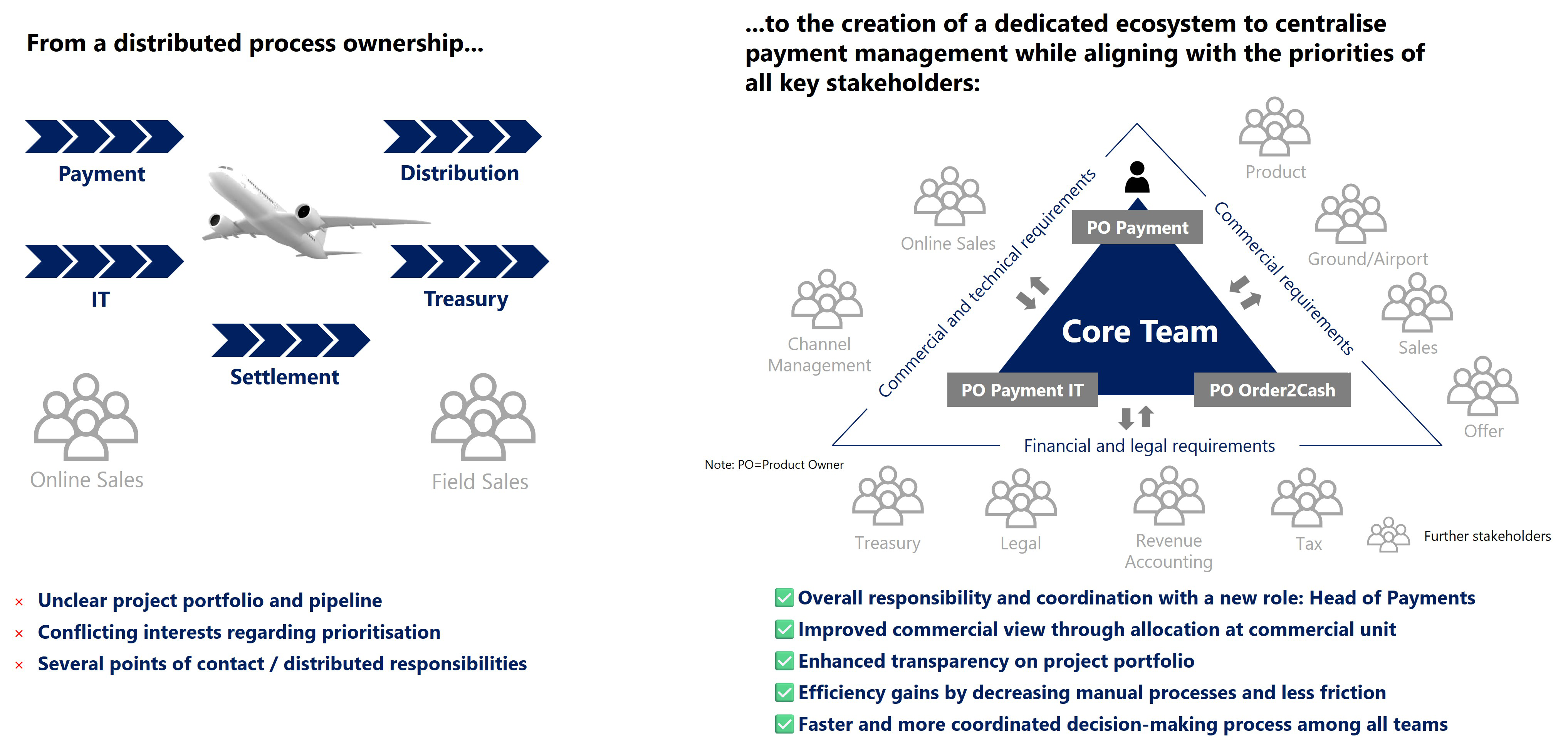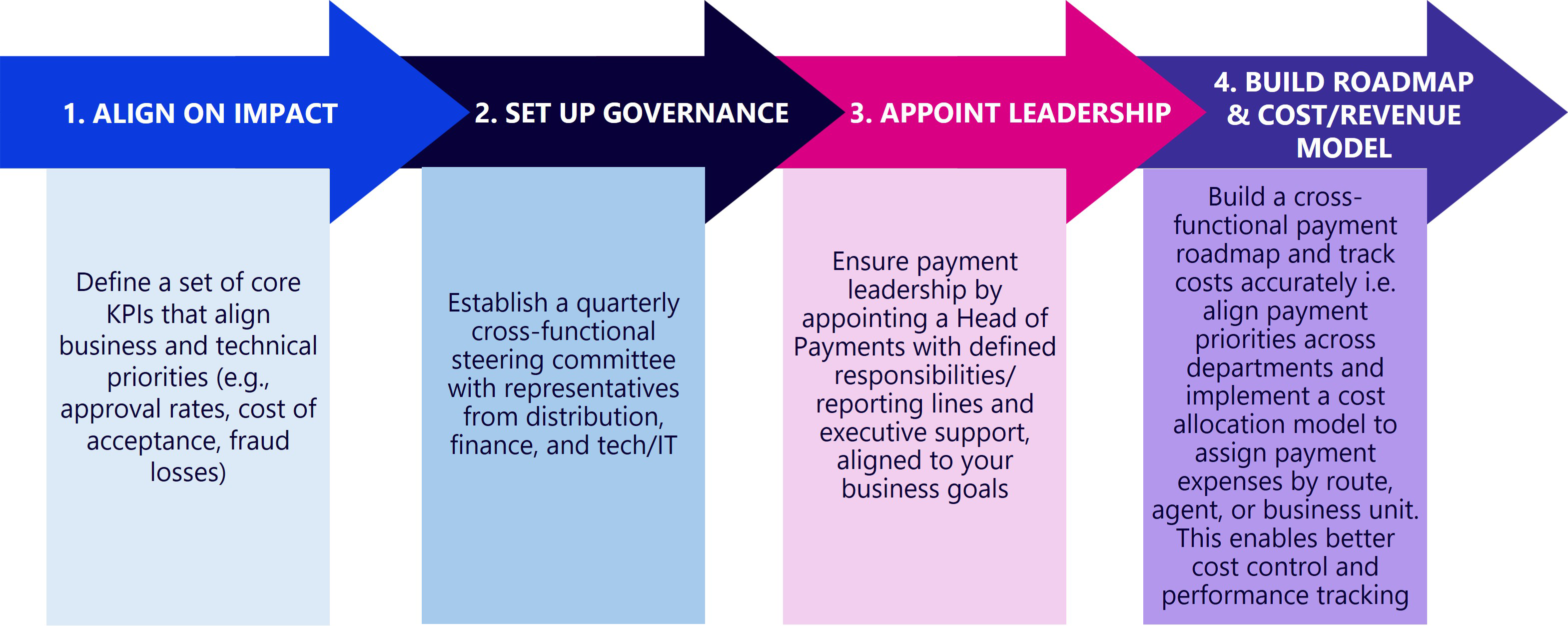Throughout 2025, Edgar, Dunn & Company (EDC)’s travel payments series continues with an exploration of an often underestimated yet foundational dimension of airline payment performance: internal organisation and governance. While the first three articles focused on external levers such as acquiring contracts and issuing strategies, this fourth article turns inward, examining how airlines organise themselves to manage payments as a strategic function.
Focus of this article
Despite the rising commercial and operational importance of payments, many airlines still rely on highly fragmented internal structures. Responsibilities are often scattered across teams such as finance, IT, or distribution, with no central point of coordination. As a result, payment-related decisions are often reactive, payment project portfolios are unclear, and strategic initiatives are slowed down by misaligned priorities or resource conflicts.

Fragmented ownership slows down progress
In our consulting work with airlines worldwide, one challenge consistently stands out: fragmented payment ownership. Responsibilities are often divided between finance, treasury, distribution, IT, customer service - with no clear owner or shared roadmap.
This fragmentation leads to unclear priorities, duplication of initiatives, and slower time-to-market. More fundamentally, it prevents payments from being treated as a strategic enabler of commercial performance. Payment innovation projects struggle to gain traction without internal sponsorship, performance monitoring remains ad hoc, and strategic questions such as payment method expansion or cost optimisation are addressed in isolation rather than holistically.
And this isn’t just an internal issue - it directly impacts customer experience. According to our 2023 report Around the World in 80 Ways to Pay with Nuvei, 74% of global travellers would abandon a booking if their preferred payment method was not available. Yet many airlines are unable to respond quickly due to internal silos. The same study found that while 80% of travellers want to split payments, only 27% of airline websites offer that option - a telling example of how fragmented ownership leads to missed opportunities.
We've also seen airlines struggle to roll out new methods like PayPal, Apple Pay or BNPL (‘Buy Now Pay Later’) globally due to misalignment between commercial teams and IT. In some cases, what should be a 2-month pilot turns into a year-long process simply because of unclear ownership or conflicting priorities between departments.
Duplicated efforts, divided outcomes: the cost of internal misalignment in payment strategy
A major European airline recently recognised that its scattered governance model was no longer fit for purpose. Although it had a number of payment initiatives underway ranging from pilots of new payment methods to IT infrastructure upgrades, there was no cross-functional coordination, no shared KPIs, and no overall strategy tying these initiatives together.
The result was a growing disconnect between ambition and execution. While commercial teams pushed for faster rollouts and better customer experience, technical and operational constraints were slowing progress. Projects were launched without fully aligned objectives, and valuable insights from one department often failed to be shared with others.
This is especially true for many tier 2 and tier 3 airlines, where this challenge is compounded by a lack of dedicated payment expertise. The strategic importance of payments is often underestimated or simply not understood. As the saying goes, you can’t value what you don’t know. Without clear ownership or internal knowledge, payments remain fragmented, and underleveraged.
A new model: centralised governance with cross-functional input
To address this, the airline created a dedicated governance structure to oversee payments end-to-end. This cross-functional group brought together stakeholders from commercial, finance, IT, legal, revenue accounting and operations, aligning priorities and decision-making under a single umbrella. The team was given a clear mandate to define the payment strategy, monitor performance, and coordinate the payment roadmap across functions.
This model enabled the airline to break down internal silos and take a more holistic approach to payment projects. Decision-making became faster and more informed. Strategic trade-offs such as balancing cost reduction with improved conversion, could be assessed more transparently. And most importantly, the payment function was no longer just reactive: it became a proactive driver of commercial and customer value.
Without clear ownership, payment projects stall. A Core Team can fix that:

Why governance is the foundation of payment maturity
Our experience at Edgar, Dunn & Company shows that payment governance is not simply an organisational question, it is a lever of transformation. Airlines that manage payments with clear ownership, defined KPIs, and cross-functional coordination are able to move faster, innovate more effectively, and deliver tangible results across cost, conversion, and customer experience.
We have seen, for instance, several airlines move from fragmented setups to appointing a dedicated “Head of Payments”, reporting into commercial or finance leadership, with a mandate to streamline payment processes across sales channels and improve cooperation and coordination between different departments. This shift often coincides with the creation of cross-functional payment committees and the formalisation of performance tracking - including but not limited to metrics such as approval rates, fraud losses, or cost per transaction split by market, payment methods and sales channels.
And governance also supports long-term resilience. In an environment where regulations evolve quickly, fraud risks increase, and customers expect seamless, omnichannel payment journeys, internal alignment becomes critical to maintaining both control and agility. A structured governance model enables airlines to respond - not react - to these challenges. It also helps them anticipate and adapt to emerging trends such as AI and agentic commerce. As AI agents begin to search, book, and pay autonomously, airlines must coordinate internally on inventory access, authentication, and payment flows to support these new types of customer journeys.
From challenge to action: what can airlines do?
While there’s no one-size-fits-all structure, four practical steps can significantly improve governance:

These building blocks often make the difference between reactive firefighting and proactive strategic execution.
Conclusion: make payment governance a strategic pillar!
Payments are no longer a back-office topic. They are a strategic domain at the intersection of finance, technology, distribution and customer engagement. But to play that role, payments need a home inside the organisation – a clear owner, a shared roadmap, and the visibility to act.
Importantly, the airline’s overarching strategy, whether cost-driven or growth-oriented, often determines which department leads the payment committee. This, in turn, shapes the committee’s strategic priorities, operating model, and ability to drive impact across functions. The Head of Payments together with the payment committee need indeed to consider all payment-related impacts and lead the coordination to drive forward a sound payment strategy.
In our next article, we will turn to a more technical, yet equally critical challenge: the complexity of airline IT payment infrastructure. As legacy systems multiply and vendor integrations grow more fragmented, many airlines are rethinking how their IT architecture can better support agility, scalability, time to market and cost control.
Please reach out to us at travelpayments@edgardunn.com if you want to share your thoughts on our articles or if you want to arrange an introduction call to discuss opportunities related to airline payments!
The content of this article does not reflect the official opinion of Edgar, Dunn & Company. The information and views expressed in this publication belong solely to the author(s).
Charlotte is a Senior Consultant based in Paris. She holds a master’s degree in management (with a finance specialisation) from Kedge Business School, Marseille. Charlotte gained 7 years of experience working as a finance and strategy specialist in France and in India and worked for some of the largest corporates, including Deloitte, L&T Technology Services in Mumbai, Société Générale Corporate & Investment Banking in France, and India. At EDC, Charlotte works on a variety of client projects, from project kick-off through to strategy conceptualisation, with colleagues in San Francisco, Dubai and London. Charlotte loves skiing and enjoys traveling around South Asia.
.webp)
%20(1).webp)

%20(1).webp)

.webp)


